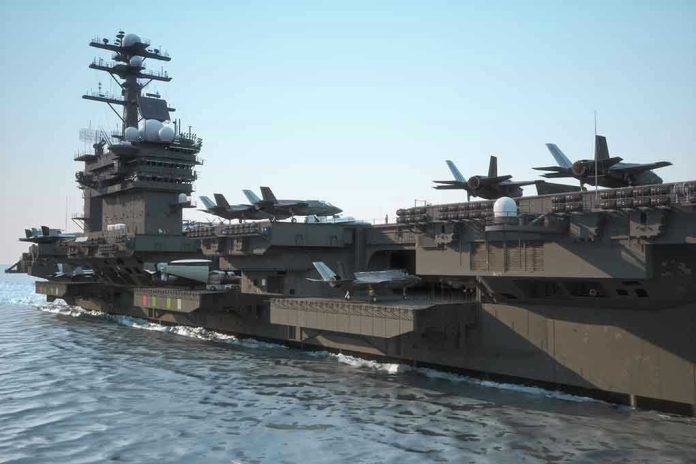
One colossal warship in Caribbean waters can tip the world’s balance of power, and right now, the USS Gerald R. Ford’s shadow stretches from Washington to Caracas, raising a question nobody can shake: what happens when superpowers stare each other down in America’s backyard?
Story Snapshot
- The USS Gerald R. Ford, the world’s largest aircraft carrier, has been deployed to the southern Caribbean, signaling a dramatic escalation in U.S. military pressure on Venezuela.
- Venezuela, led by Nicolás Maduro, has responded with sweeping military mobilization and urgent calls for Russian, Chinese, and Iranian support.
- Both nations are engaged in aggressive posturing, raising the specter of military miscalculation and regional instability.
- Behind the maneuvers lies a web of geopolitics, criminal crackdowns, and a contest for influence that could redraw alliances across Latin America.
USS Gerald R. Ford’s Arrival Redefines the Caribbean’s Balance of Power
Late October 2025, the U.S. Navy’s most formidable war machine, the USS Gerald R. Ford, slipped into the turquoise theater of the southern Caribbean. Officially, the mission targets transnational criminal organizations, but the reality on the water and in diplomatic backchannels is far sharper. This deployment is a direct message to Venezuela’s embattled president, Nicolás Maduro: American power is parked at your door, and the world is watching. The Ford’s arrival is not isolated; it caps months of tit-for-tat—fighter jets buzzing destroyers, warships intercepting fishing boats, and bombers roaring just outside Venezuela’s airspace. Each move inches the region closer to a standoff that could upend decades of uneasy peace.
Military planners call it deterrence, but for the Caribbean’s fishermen, oil workers, and families, it means anxiety pulsing beneath the surface. The Ford’s deck bristles with advanced F-35 fighters, and its escort fleet is the largest the region has seen in a generation. On the mainland, Maduro’s government declares a state of alert, mobilizing troops and scrambling for foreign military aid. Russia obliges with aircraft landings, and both China and Iran receive desperate calls for support. The U.S. insists its motives are anti-crime, but few accept that at face value; this is high-stakes power politics, with the world’s most advanced warship as the centerpiece.
Decades of Tension Set the Stage for Today’s Confrontation
The roots of this confrontation run deep. Since the days of Hugo Chávez, Venezuela’s socialist leadership and Washington have been on a collision course. U.S. sanctions, diplomatic pressure, and support for opposition figures hardened the rift through the 2010s and 2020s, especially as Maduro clung to power. The Caribbean, once a sleepy backdrop for anti-drug patrols, has become a chessboard for global influence. Previous U.S. naval buildups and counter-narcotics operations linger in regional memory, but the Ford’s deployment surpasses them all, drawing in Moscow, Beijing, and Tehran as counterweights to American might. Each side accuses the other of provocation; both prepare for scenarios where brinkmanship tips into conflict.
Every major escalation—Venezuelan F-16s shadowing U.S. destroyers, American bombers flying within sight of Caracas, Russian military aircraft landing on Venezuelan soil—adds a layer of risk. Diplomatic channels fray, and the chance for miscalculation grows. Neighboring nations watch uneasily, wary of disruption to trade, fishing, and the ever-present threat of refugees spilling across borders if hostilities flare.
Strategic Calculations and Geopolitical Stakes Drive Both Sides
For the United States, the Ford’s forward position is about more than regional policing. It’s a signal: American resolve remains unchallenged in the hemisphere, and no adversary can operate in its backyard unchecked. The Pentagon’s public focus on transnational crime barely masks the underlying message to Maduro—relinquish power or face overwhelming force. Yet Washington knows a full-scale invasion is unlikely; the real weapon is pressure, both military and psychological. The Ford’s presence compels Venezuela’s leaders to divert resources, seek foreign guarantees, and brace for the unpredictable.
For Maduro’s regime, survival depends on projecting defiance and courting external support. The government frames the U.S. deployment as imperial aggression, calling on allies in Moscow, Beijing, and Tehran for aid. Russia’s quick response with military assets, and the visible signals of Chinese and Iranian interest, create a volatile mix. Venezuela’s reliance on asymmetric tactics—mobilizing forces, launching exercises, and exploiting propaganda—reflects both its military limitations and its leaders’ determination to resist American pressure. The outcome of this contest will reverberate far beyond Caracas, influencing alliances and stability across Latin America for years to come.
Risks of Escalation and Global Ramifications
The risks of miscalculation are acute. Experts warn that the sheer concentration of advanced weaponry and the presence of multiple foreign actors raise the odds of accidental conflict—an errant missile, a misidentified aircraft, a misread radar signature. The effects would be immediate: disruption of oil exports, economic turmoil, and the prospect of humanitarian crises as civilians flee potential hotspots. U.S. and Venezuelan officials trade accusations in the media, but neither side can fully control the narrative or the cascade of consequences should a spark ignite open hostilities.
For Latin America, the standoff is a stark reminder that local disputes can draw in global powers and reshape the regional order. Defense industries prepare for increased demand; energy markets brace for shocks; and Caribbean governments quietly review contingency plans for mass migration. While neither Washington nor Caracas seeks outright war, the collision of pride, politics, and military hardware leaves no guarantee that peace will hold. The world’s largest aircraft carrier is more than a symbol—it is a test of resolve, strategy, and the unpredictable nature of confrontation in the 21st century.
Sources:
Wikipedia: 2025 United States naval deployment in the Caribbean













